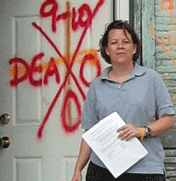
 |
||
The Yale Alumni Magazine is owned and operated by Yale Alumni Publications, Inc., a nonprofit corporation independent of Yale University. The content of the magazine and its website is the responsibility of the editors and does not necessarily reflect the views of Yale or its officers. |
Mary Ruffin Hanbury ’88 left her job as program officer at the National Trust for Historic Preservation in July 2005 to get married (to John Oates '83, whom she met at a Yale reunion) and move to Raleigh, North Carolina. Ten weeks later, Hurricane Katrina wracked the Gulf Coast, and Hanbury’s old employer called her up with a new job offer—would she go to New Orleans and coordinate the Trust’s volunteer efforts there? She arrived on October 17; we talked to her in mid-November. Y: So what exactly are you doing in New Orleans? H: My job is to coordinate the work of volunteers who are coming in to work with a local preservation group and with homeowners. I look for teams that are diverse in every sense. Most of the people are oriented toward preservation—we’ve had museum curators, for example. We get a new team in every Sunday. Monday we have orientation, and Tuesday, Wednesday, and Thursday we do field work. Friday we wrap up, and then we start fresh again on Sunday with new people. Y: What kind of field work? H: Going out into affected neighborhoods and doing outreach. We’re focusing on homeowners. Gossip is the stock-in-trade down here, and homeowners are most likely to get the bad information that we want to dispel. We give people information about how to restore their houses, we give away free buckets of paint, tarps, cleaning supplies, fans to air out their rooms—because mold grows with water. There are big neighborhoods that still have no utilities. How do you come home and clean something if you have no water? Many people from New Orleans are living in other towns these days—they’ll commute into New Orleans in the morning, and then go back to Baton Rouge, where they have utilities, at night. Y: What about you—do you have utilities? H: There’s no gas at the bed-and-breakfast where I’m staying, so there’s no hot water and no stoves. I take cold showers. This is so small compared to what other people are suffering. Y: What do these neighborhoods look like? H: There’s always stuff in front of flooded houses. The books kill me. Plus record albums, stuffed animals, boxes of bills—all in a big pile over your head. There are big piles of garbage two stories tall. All these little objects, each one with a story, each one belonged to someone and has been thrown away. The sheer overwhelming size of the misery is just phenomenal. The first day, it was like looking at the impact of a neutron bomb—and then, things that aren’t normal just begin to seem normal. The water lines can be ten feet high on the sides of some houses. And then there are spray-paint marks left by the National Guard in front of buildings to show they’ve searched them. They leave symbols that mean they found people or animals dead on arrival. Y: How has the time you’ve spent in New Orleans affected you emotionally? H: When you see the markings that indicate that a person or an animal died inside, or a hole that someone cut out of a house while trying to escape, you do need to take a moment. Every person at the end of the day needs to decompress and take some quiet time. Sometimes we go to the French Quarter or the Garden District at night. More restaurants are open there, and that feels normal. Everyone who comes seems to be doing a lot of writing—blogging, or sending e-mails to friends at the end of the day. There’s something very cathartic in it even though it just breaks your heart. Many of them say things like 'I’m going be an ambassador, I’m going to go back and tell people what I saw, talk to my Rotary club, talk to my congressman.” These people will continue to volunteer after they leave here. Y: You worked for many years in architectural preservation. What is special about New Orleans architecture? H: New Orleans has over 57,000 houses that the National Trust defines as historic—that’s an amazing number. There are also some very specific vernacular types, creole cottages and shotgun houses in particular. And across the board in New Orleans, people realize that these structures are culturally important. It’s trendy to live in a creole cottage, even though it is a small house by American standards. Y: You grew up in the South and you’ve been to New Orleans many times. Has this experience changed your outlook? H: It’s very rare in the course of your career that you can help put back together a wonderful city that has gone through a horrible thing. The resources in New Orleans are unique and unparalleled in the country, and the scope of this disaster is unprecedented. I know that Thanksgiving will always be, qualitatively, a different experience for me after this. We are so lucky in most of the world and most of the country to be living the kinds of lives that we do. It teaches you where your priorities ought to be. Y: Have you seen signs of improvement in the city since you arrived? H: Things are getting better—people should believe that—but the need continues, so please don’t get complacent, and don’t forget us down here. A big mound of garbage just doesn’t look that big in a photograph. |
|
|
|
|
|
|
|
|
©1992–2012, Yale Alumni Publications, Inc. All rights reserved. Yale Alumni Magazine, P.O. Box 1905, New Haven, CT 06509-1905, USA. yam@yale.edu |
||
